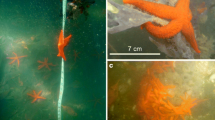Abstract
The body size and shape ofD. longispina in small and large rock-pools was measured. The mean body length ofDaphnia in large rock-pools with vertebrate planktivores was smaller than that ofDaphnia in small rock-pools without vertebrates, but the variability in body lengths within pools over the season was as great as that found between pools and predator regimes. We did find thatD. longispina in large rock-pools produced one egg at a smaller body length and had fewer eggs per individual than didDaphnia in small rock-pools.D. longispina populations also showed different body shapes both as the season progressed and in rock-pools having different predator composition. As expected inDaphnia cyclomorphosis, the core body length decreased during the summer, accompanied by significantly more pointed heads and longer tail spines than in early summer.D. longispina in large rock-pools (with vertebrate predators) have significantly larger exuberances than those in small rock-pools (lacking vertebrate planktivores). The results are discussed in the context of size-selective predation.
Similar content being viewed by others
References
Anderson, R. S., 1980. Relationships between trout and invertebrate species as predators and the structure of the crustacean and rotiferan plankton in mountain lakes. In W. C. Kerfoot (ed.), Evolution and ecology of zooplankton communities. University Press of New England, Hanover: 635–641.
Brooks, J. L. & S. I. Dodson, 1965. Predation, body size and composition of zooplankton. Science 150: 28–35.
Confer, J. L., G. Applegate & C. E. Evanik, 1980. Selective predation by zooplankton, and the response of cladoceran eyes to light. In W. C. Kerfoot (ed.), Evolution and ecology of zooplankton communities. University Press of New England, Hanover: 604–608.
Dolmen, D. & J. I. Koksvik, 1983. Food and feeding habits ofTriturus vulgaris (L.) andT. cristatus (Laurenti) (Amphibia) in two bog tarns in central Norway. Amphibia-Reptilia 4: 17–24.
Gliwicz, Z. M., 1977. Food size selection and seasonal succession of filter feeding zooplankton in an eutrophic lake. Ekol. pol. 25: 179–225.
Gliwicz, Z. M. & E. Siedlar, 1981. Food size limitation and algae interfering with food collection inDaphnia. Arch. Hydrobiol. 88: 155–177.
Greene, C. H., 1983. Selective predation in freshwater zooplankton communities. Int. Revue ges. Hydrobiol. 68: 297–315.
Hebert, P. D. N., 1977. Niche overlap among species in theDaphnia carinata complex. J. anim. Ecol. 46: 399–409.
Hessen, D. O., 1985. Selective zooplankton predation by preadult roach (Rutilus rutilus): The size-selective hypothesis versus the visibility-selective hypothesis. Hydrobiologia 124: 73–79.
James, F. C., 1982. The ecological morphology of birds: a review. Ann. zool. fenn. 19: 265–275.
Jolicoeur, P. & J. E. Mosiman, 1960. Size and shape variation in the painted turtle. A principal component analysis. Growth 24: 339–354.
Kerfoot, W. C., 1980a. Commentary: Transparency, body size, and prey conspicuousness. In W. C. Kerfoot (ed.), Evolution and ecology of zooplankton communities. University Press of New England, Hanover: 609–617.
Kerfoot, W. C., 1980b. Perspectives on cyclomorphosis: Separation of phenotypes and genotypes. In W. C. Kerfoot (ed.), Evolution and ecology of zooplankton communities. University Press of New England, Hanover: 470–496.
Kerfoot, W. C., 1981. Long-term replacement cycles in cladoceran communities: a history of predation. Ecology 62: 216–233.
Lindberg, H., 1944. Ökologisch-geographische Untersuchungen zur Insektenfauna der Felsentümpeln an den Küsten Finnlands. Acta zool. fenn. 41: 1–180.
Nilsson, N.-A. & B. Pejler, 1973. On the relation between fish fauna and zooplankton composition in north Swedish lakes. Rep. Inst. Freshwater Res. Drottingholm 53: 51–77.
Pajunen, V. I., 1977. Population structure in rock pool corixids (Hemiptera, Corixidae). Ann. zool. fenn. 14: 26–47.
Pajunen, V. I., 1983. Prey selection by larvae ofPotamonectes griseostriatus (Degeer) (Coleoptera, Dytiscidae). Ann. zool. fenn. 20: 31–35.
Ranta, E. & V. Nuutinen, 1984. Zooplankton predation by rockpool fish (Tinca tinca L. andPungitius pungitius L.): an experimental study. Ann. zool. fenn. 21: 441–449.
Ranta, E. & V. Nuutinen, 1985a. Foraging by the smooth newt (Triturus vulgaris) on zooplankton: functional responses and diet choice. J. anim. Ecol. 54: 275–293.
Ranta, E. & V. Nuutinen, 1985b.Daphnia exhibit diurnal vertical migration in shallow rock-pools. Hydrobiologia 127: 253–256.
Salo, J., M. Walls, M. Rajasilta, M. Räsänen & V.-P. Salonen, 1986. Changes in carapace length ofBosmina coregoni after whitefish introductions. Manuscript.
Sokal, R. & F. J. Rohlf, 1981. Biometry. Second edition. Freeman, San Francisco, 859 pp.
Zaret, T. M., 1969. Predation-balanced polymorphism ofCeriodaphnia cornuta Sars. Limnol. Oceanogr. 14: 301–303.
Zaret, T. M., 1980. Predation and freshwater communities. Yale University Press, New Haven, 187 pp.
Zaret, T. M. & W. C. Kerfoot, 1975. Fish predation onBosmina longirostris, body-size selection versus visibility selection. Ecology 56: 232–237.
Author information
Authors and Affiliations
Rights and permissions
About this article
Cite this article
Ranta, E., Tjossem, S. Size and shape ofDaphnia longispina in rock-pools. Hydrobiologia 145, 259–268 (1987). https://doi.org/10.1007/BF02530286
Issue Date:
DOI: https://doi.org/10.1007/BF02530286




